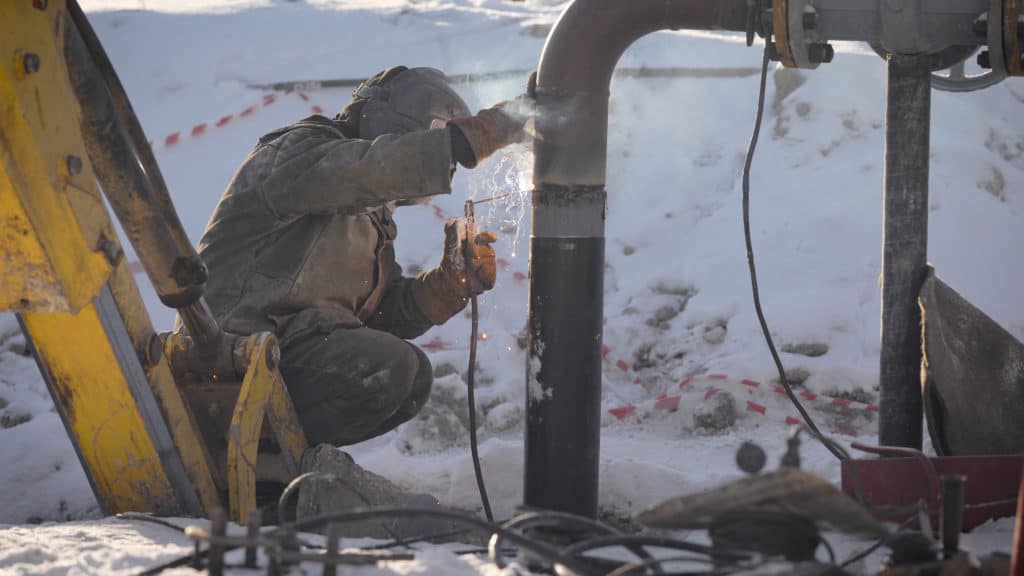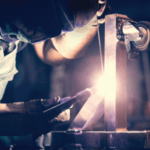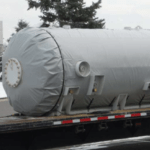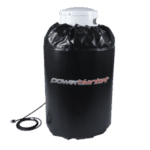Whether you refer to it as oxy-fuel welding, oxy welding, or simply gas welding, it doesn’t come without its challenges. Weather and environment create additional challenges for welders, their torches, gas welding tanks, and welding materials. Welders are pros at adapting and overcoming these challenges and over the years have developed methods for staying one step ahead of mother nature on a welding job.
When Is It Too Cold To Weld?
If you run a business and desperately need welding repairs done so you can get back to work, your answer would be “never.” If you rely upon welding to make a living, your answer would also probably be “never.” Industrial deadlines cannot always wait for warmer weather. However, precautions need to be taken to ensure human safety, equipment protection, and weld integrity. Let’s take a closer look at 1 of these cold weather welding challenges.
Effects Of Cold On Gas Welding Tanks
No matter what gas mixture you use, cold temperatures will make it difficult, and potentially impossible to weld in the dead of winter. When embarking upon a winter project, it may feel like there are many elements which are out of your control. One element that you can take control of is the temperature of your welding gas tank.
Frozen Regulators
The regulator acts as a barrier between the high pressure inside the tank and the low pressure of the ambient air. The pressure, volume, and temperature of a gas are all related. As the gas enters the regulator, its pressure decreases and so does its temperature. Even under normal temperatures, frost can develop on a gas cylinder regulator. The frost that develops during normal weather is the result of condensation. However, during the winter, regulators can become frozen both inside and out. Frozen regulators can block the flow of gas completely.
Reduced Gas Flow
When the temperature of a tank falls, so will the gas pressure within the tank. When it comes to producing clean and flawless weld joints, consistent temperature of your gas is an important matter to regulate. Whether you’re using acetylene, argon, hydrogen, propane/butane, or propylene, the answer is the same. You need to maintain an ideal temperature for a consistent extraction rate. When the temperature drops, it’s very difficult to maintain optimal pressure in a cylinder tank of any size.
Liquefaction and Separation
Cold temperatures can cause gases to liquefy and settle at the bottom of a cylinder. Cylinders with a mixture of gases are prone to partial liquefaction and uneven settling. As temperatures drop, the gases in the cylinder will liquefy, settle, and separate. When your gas quality diminishes, so do the quality of your welds.
Lower Weld Quality
You need a consistent extraction rate in order to create strong and aesthetically appealing weld joints. When the psi is low and the gas flow rate is sporadic, it causes pin holing and spattering in your weld joints. These defects are not just superficial. They can also lower the strength and integrity of your welds.
Regulated Tank Heating Benefits
Ideal tank temperatures facilitate ideal gas extraction, which in turn, offers ideal welding. Heating your tank, especially when working in cold weather, will increase the PSI considerably. Of course, you don’t want the PSI too high either, and that’s why we use the term regulated heat. Maintaining the ideal temperature will help produce the best flow rate and will prevent pin holing and spattering.
*If you are interested in learning more about different gas mixtures, visit the Compressed Gas Association (CGA) website. The CGA offers extensive training on different gases and gas mixtures including their properties, uses, and safety recommendations.
Powerblanket Gas Welding Tank Solutions
Gas Cylinder Heaters
Whether you use a small or large tank for your gas welding, we have a solution for you. Powerblanket offers a variety of gas cylinder heaters and propane tank heating solutions. Our heaters safely control the cylinder temperature for propane, argon, butane, nitrogen, oxygen and other compressed gases. In addition, they are certified to meet UL, CSA, and CE standards with options for hazardous location certifications, class I, division 2 (C1D2).
Powerblanket Gas Cylinder Heater Benefits:
- Increase performance and efficiency of gas cylinders
- Provide heat where you need it
- Save money by optimizing gas and material usage
- Safety certified to UL/CSA standards
- Eliminate unnecessary cylinder refills in cold weather
- Produce ideal flow rates
- Eliminate pin holing and spattering in welding applications
Contact us to find the right cold weather welding solutions for your needs at 844.245.6604 or [email protected]
Frequently Asked Questions
How big of a welding gas tank do I need?
The size of the welding gas tank you need depends on your welding duration, with a general guideline being 20 cubic feet of capacity for every hour of welding.
What gas is in welding tanks?
Welding tanks commonly contain gases such as argon, carbon dioxide, and various mixtures like a 75% argon and 25% carbon dioxide blend, depending on the welding process requirements.
How long will 20 cu ft argon last?
A 20 cubic foot argon tank typically lasts around 10-12 hours of welding time, considering an average shielding gas flow rate and typical arc-on time.
Can you patch a hole in a gas tank with JB Weld?
Yes, JB Weld can be used to repair holes in gas tanks, but it's crucial to follow the recommended curing time before refilling the tank with gas.
Powerblanket's superior heating solutions reduce costs by optimizing container temperatures and increasing cylinder efficiency.










